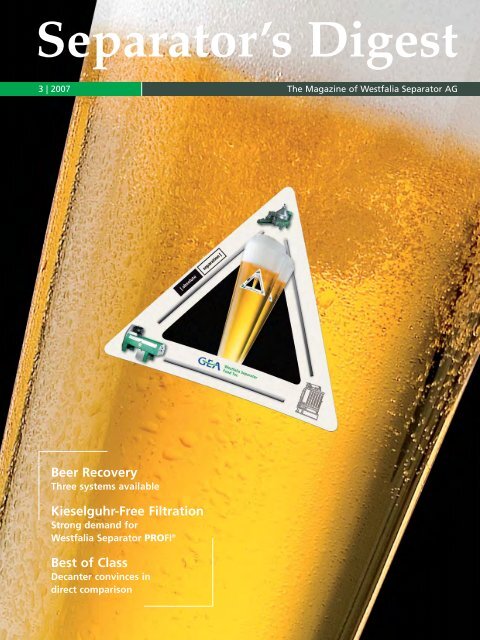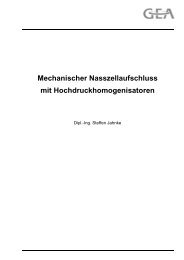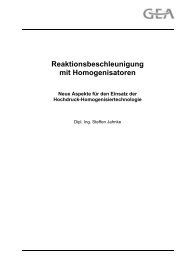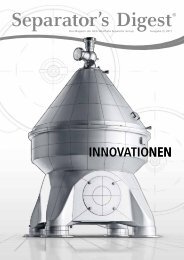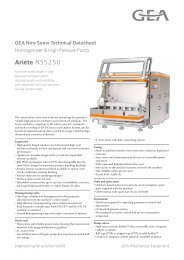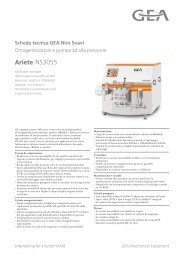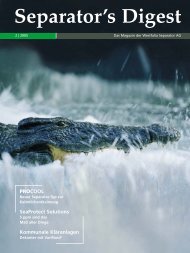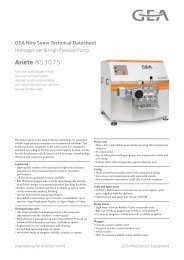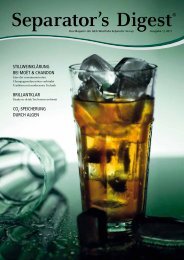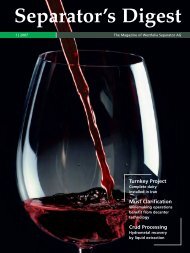Separator's Digest 2007/3 - GEA Westfalia Separator Group
Separator's Digest 2007/3 - GEA Westfalia Separator Group
Separator's Digest 2007/3 - GEA Westfalia Separator Group
- No tags were found...
You also want an ePaper? Increase the reach of your titles
YUMPU automatically turns print PDFs into web optimized ePapers that Google loves.
<strong>Separator</strong>‘s NewsFive UCB 635 Decanters at the Waste WaterTreatment Plant in HetlingenIt is the first decanter of this size operating in a Europeanmunicipal waste water treatment plant, equipped with <strong>Westfalia</strong><strong>Separator</strong> VariPond ® .With a population connectionvalue of 750,000 inhabitantsand population equivalent, thewaste water treatment plantin Hetlingen is one of threewaste water treatment plantsresponsible for processing anddisposing of effluent from thegreater region of Hamburg. In2003, the water board decidedto test the first dewateringdecanter type UCB 635, initiallyon a rental basis. After twelvemonths of trouble-free dewateringoperation with a capacityof 50 m 3 digested sludgeper hour, the first decanterwas purchased from <strong>Westfalia</strong><strong>Separator</strong>. To provide back-upfor this major process stage,Hetlingen installed a secondidentical machine in the autumnof 2004, and this machine actsas a standby installation. Thissuccessfully completed the’dewatering’ project.The water board went furtherand gradually replaced theexisting older type of thickeningcentrifuges used forthickening the surplus activatedsludge. The first thickeningdecanter type UCB 635 with<strong>Westfalia</strong> <strong>Separator</strong> VariPond ®regulation commenced operationin the spring of 2005. It isthe first decanter of this sizein a European municipal wastewater treatment plant to beequipped with <strong>Westfalia</strong><strong>Separator</strong> VariPond ® . In thefinal stage, two further thickeningdecanters of the samedesign were commissioned inDecember 2006. One machineis designed as a twin-functiondecanter for thickening and asa reserve unit for dewatering.The water board Pinneeberghas thus created the basis for aforward-looking concept fordewatering and thickening.New Authorized Workshop in JapanThe subsidiary <strong>Westfalia</strong> <strong>Separator</strong> K.K., Japan, has successfullycompleted the certification procedure to be classified as an’authorized workshop’. This provides a further major basein Asia at which service and repair work can be carried out inaccordance with the safety specifications of <strong>Westfalia</strong> <strong>Separator</strong>AG. Within the framework of the certification procedure, <strong>Westfalia</strong><strong>Separator</strong> AG officially nominated Yukio Muhto as a Safety Officerafter he had successfully completed the training program.Yukio Muhto (middle) is the official Safety Officer in Japan.<strong>Separator</strong>’s <strong>Digest</strong> 3 | <strong>2007</strong>4<strong>Separator</strong>’s News
<strong>Separator</strong>‘s NewsAuthorized Workshop in South Africa<strong>Westfalia</strong> <strong>Separator</strong> (S.A) (Pty.) Ltd., South Africa, has now met allthe necessary criteria to be nominated as an authorized workshop.COO Werner Kohlstette opened the authorized workshop with atotal of 100 customers, friends and employees. Some customershad travelled more than 700 kilometres in order to attend theevent. Richard Plazier, Managing Director of <strong>Westfalia</strong> <strong>Separator</strong>South Africa, provided an insight into the Original ManufacturerService philosophy. <strong>Westfalia</strong> <strong>Separator</strong> South Africa is now able tosupply all types of Original Manufacturer Service to itscustomers in its area of responsibility, namely the countries to thesouth of the Sahara. This foundation forms the basis forsigning service agreements in various stages and thus for a bettercustomer understanding.Safety Officer Training ProgramService and repair work are becomingmore and more important – world-wide.Numerous organisational and personnelrequirements have to be guaranteed toensure optimum processing, becausethe safety of separators and decantersis extremely important. Authorizedworkshops form a network around theworld. Service and repair work is carried outin these workshops in line with the safetyphilosophy of <strong>Westfalia</strong> <strong>Separator</strong>.For subsidiaries of <strong>Westfalia</strong> <strong>Separator</strong>wanting to acquire the ’authorizedworkshop’ certificate, the first step inthe certification process is to submit anapplication to <strong>Westfalia</strong> <strong>Separator</strong> AG. Theapplication requires a presentation of thecompany with an organisation chart and apresentation of the planned repair work aswell as the name of a future Safety Officer.The Safety Officer supports the ManagingDirector in all aspects of safety of serviceand repair work. At the same time, he is thecontact for the market companies andmaintains contact with the design andspecialist departments within the <strong>Group</strong>.The training program ’Organisation andSafety for Service and Repair Work’ inOelde and Niederahr lasts for several weeksand every future Safety Officer is able to getto know different specialist departmentsand contacts who will subsequently be ableto support him in his work and efforts toanswer repair questions. In this way, heobtains the basic information necessary forhis work as a ’Safety Officer’. At the end ofthe training process, the candidate hasto demonstrate his specialist knowledgebefore he is officially nominated as a’Safety Officer’ and before he is handed thecorresponding certificate.Safety philosophy has top priority in theSafety Officers' training program.<strong>Separator</strong>’s News 5<strong>Separator</strong>’s <strong>Digest</strong> 3 | <strong>2007</strong>
<strong>Separator</strong>‘s NewsMajor Order from Russia for Oil Additive ProductionAt the beginning of <strong>2007</strong>, a major customerfrom Russia placed an order for two gas-tightdecanters type CC 458 and two gas-tightseparators type SE 75 with the Business UnitChemistry, Pharmaceuticals andBiotechnology of <strong>Westfalia</strong><strong>Separator</strong> Industry. Themachines are to separatesolids from an organicliquid obtained duringthe production of oil additives.Oil additives are usedfor lowering the viscosity oflubricants to reduce wearand oil consumption. The separating processtakes place in two stages: the high solids contenthas to be handled in the first stage by the decanters;the two SE 75 separators are then responsiblefor removing the very fine particles from thedecanter overflow.In the past, the user has had very positiveexperiences with <strong>Westfalia</strong> <strong>Separator</strong> withseveral SB 60 machines. <strong>Westfalia</strong> <strong>Separator</strong> alsoprovided the advantage of being able to offer acomplete solution including separation stages,process engineering and process integration.The decanters remove themajority of solids in the first stage,then the separators remove the fineparticles left in the decanter oveflow.Good Results on MS Norwegian WindIn 2006, Norwegian CruiseLines tested eight new OSDmachines from <strong>Westfalia</strong><strong>Separator</strong> and a sludge processinginstallation on the NorwegianWind. The results showedthat huge savings were achievedin one year owing to the lowervolume of sludge achievedby using the OSD separators.This meant less sludge to bedischarged at ports and a lowerconsumption of lubricating oil.As the prices of heavy fueloil, diesel oil and lube oil areconstantly rising, and also inview of the higher charges fordischarging sludge and spentoil, Norwegian Cruise Lineshad looked around for newtechnical solutions to reducethese costs. Several of its cruiseliners operate around Hawaiiand Alaska. The costs fordischarging sludge and spentoil are extremely high in theharbours in these countries;in Hawaii for instance, thecosts are USD 350 per cubicmetre. <strong>Westfalia</strong> <strong>Separator</strong>then submitted proposals forcleaning heavy fuel oil and lubeoil and also for minimisingsludge disposal costs. The offerincluded separators from theD-series and SludgeMaster 300.At the beginning of 2006, theheavy fuel oil and lubeoil separators of the D-seriesand the ESD 18 SludgeMasterinstallation were delivered toMS Norwegian Wind. Thedelivery comprised OSD 35machines for treating the heavyfuel oil, four OSD 18 machinesfor treating the lube oil, twoOSD 18 machines for treatingthe lube oil of the auxiliarymachines and one type ESD 18SludgeMaster installation. Themachines were installed andcommissioned at sea. The initialresults on Norwegian Windwere so good that NorwegianCruise Lines, following thesuccessful trial with the D-serieson MS Norwegian Wind, placeda further order for retrofittingthe separators on MS NorwegianDream. These wereinstalled in mid <strong>2007</strong>.<strong>Separator</strong>’s <strong>Digest</strong> 3 | <strong>2007</strong>6<strong>Separator</strong>’s News
<strong>Separator</strong>‘s NewsSeatrade CruiseShippingConvention <strong>2007</strong>STAFF NEWSOliver Best is NowDeputy Head of ProductionThis year’s Seatrade Cruise Shipping Convention<strong>2007</strong> was held between 13 and 15 March inthe Miami Beach Convention Center in Florida.Approximately 900 exhibitors from 100 countriespresented their products. As was the casein pervious years, <strong>Westfalia</strong> <strong>Separator</strong> wasrepresented on a stand in the German pavilion.The BilgeMaster-D 1500 in compact design withseparator WSD 8 again met with keen interest,as was the case with the SeaProtect Solutionsincluding the SludgeMaster as well as the entireBilgeMaster-D product family. With a performancerange of 1000 to 7000 l/h bilgewater, they offerthe suitable installation for vessels of all sizes. Thethree basic models WSD 8, WSD 18 and WSD 35are combined with five adsorption filters ofdifferent sizes to form a total of nine versions.There is also the BilgeMaster 200 with a WTC 2for a capacity of 200 l/h on smaller vessels.Numerous representatives from well-knownshipping companies, as well as their spare partspurchasers, visited the exhibition stand. <strong>Westfalia</strong><strong>Separator</strong> Mineraloil Systems was thereforemore than satisfied with the exhibition, and willbe attending the Seatrade Cruise ShippingConvention in 2008.Oliver Best (38) joined <strong>Westfalia</strong> <strong>Separator</strong> Food Tec asDeputy Head of Production, and supports GerhardPopuloh in this function. At the same time, he receivedfull powers of representing the company. After studyingengineering, specialising in production technology, OliverBest worked for Hermes Schleifmittel GmbH in Hamburg,for seven years, and was head of production for four yearsduring that time. Then he was the head of production atMaschinenbau Kitz GmbH in Troisdorf.Thomas Schmitz is theNew Managing Director in ChinaThomas Schmitz is been the new Managing Directorof <strong>Westfalia</strong> <strong>Separator</strong> China Ltd. After completing hisengineering studies in Berlin in August 1990, he worked invarious capacities for Flaekt/ABB/ALSTOM, most recentlyin Malaysia as the Head of Business Development forSouth-East Asia and as General Manager Power StationService for Singapore and Vietnam.Bernd Huber Chairman of theBoard of Managing Directors of<strong>Westfalia</strong> <strong>Separator</strong> Food TecDiplom-Ingenieur Bernd Huber (48) is the new Chairmanat <strong>Westfalia</strong> <strong>Separator</strong> Food Tec, and is also a memberof the Division Board. After completing his studies ofengineering/ production technology, Bernd Huber workedas a production manager and subsequently as managingdirector in various companies. Between 2000 and 2003,he was Division President of the former L-Division of the<strong>GEA</strong> <strong>Group</strong>. Bernd Huber is responsible for Productionand Design of <strong>Westfalia</strong> <strong>Separator</strong> Food Tec. MarkusHüllmann is responsible for Sales and Thomas Pelzer forthe Commercial Sector.
<strong>Separator</strong>‘s NewsFirst Disc-Type Centrifugein the World in the GermanCentrifuge MuseumThe invention of the firstcentrifuge by the Germanengineer W. Lefeldt in 1875initiated a development whichattracted worldwide attention.The disadvantage of thesecentrifuges was that they wereequipped only with a chambertypebowl which providedsatisfactory separating resultsonly in conjunction with lowthroughput capacities. Dr.Ing. h.c. Clemens Freiherr vonBechtolsheim, who was workingin Munich on designing saltcentrifuges, was asked todesign a simple milk centrifuge.He started work, and built thefirst disc-type centrifuge in theworld, and <strong>Westfalia</strong> <strong>Separator</strong>was awarded the patent on14 July 1888 by the ImperialPatent Office. The bowl withthe conical disc stack is definedas a milestone in the history ofcentrifugal technology. Thesuccess of this separator with adisc-type bowl was due tothe following fact: comparablemanual centrifuges achieveda capacity of 100 litres perhour and a residual fat contentof 0.3 percent in the skimmilk. On the other hand,the Bechtolsheim centrifugeachieved a performance of250 litres per hour and aresidual fat content of only0.14 percent in the skim milk.His first model is still to befound in the DeutschesMuseum in Munich. With thekind permission of the DeutschesMuseum, a group headedby the <strong>Westfalia</strong> <strong>Separator</strong>employee Dietrich Bretz hasworked together with thetraining workshop at Oeldeand has built an exact replicaof the centrifuge. The first disctypecentrifuge in the world isnow also a special attraction inthe collection of the GermanCentrifuge Museum on theworks premises of <strong>Westfalia</strong><strong>Separator</strong> in Oelde.Environmental Protection for FibreglassProduction in LatviaValmieraGlasfaser AG in Valmiera,Latvia, one of the largest companies in thechemical and textile industry in the Baltic, has specialised inthe production and processing of fibreglass for five decades. Thecompany uses its own waste water treatment plant for clarifyingthe effluent produced in the process.The Preiss-Daimler-<strong>Group</strong>, the parent company of ValmieraGlasfaser AG, has been using a decanter from <strong>Westfalia</strong> <strong>Separator</strong>in its chemical/physical waste water treatment plant in Oschatz,Saxony, for more than ten years. The Latvian subsidiary has nowalso decided to use the tried-and-trusted decanter technology.Since March <strong>2007</strong>, the decanter type UCD 305 has been processingthe floatation sludge, which is difficult to dewater, without anyproblem. Fibreglass is a chemical inorganic fibre obtained frommolten glass of a certain composition. Because fibreglass is madeonly from natural materials such as quartz, sand, limestone, kaolin,calcium fluoride, boric acid, sodium sulphate and alumina, itsproducts are ecologically pure and are not hazardous tohealth. Fibreglass can be twined, warped, and woven, and also beprocessed in the same way as any other fibre. Properties such asstrong resistance, non-flammability, resistance to chemical andbiological influences as well as a relatively low density enable awide range of products to be manufactured. Fibreglass is used inthe electro-technical industry, aviation and the space industryas well as in the engineering and automotive industries. Fibreglassis also used for making surfboards, rowing boats, skis andartificial limbs.<strong>Separator</strong>’s <strong>Digest</strong> 3 | <strong>2007</strong>8<strong>Separator</strong>’s News
<strong>Separator</strong>‘s NewsDecanter Technologyfor Protecting the BalticEffluent processing has a long tradition in theHanseatic city of Rostock. The city has beenoperating its own waste water treatment plantsince 1913. The last waste water treatment plant,built in 1952 in the district of Bramow anddesigned for 150,000 inhabitants, has nowhad to be thoroughly upgraded and expandedfor 400,000 inhabitants. The demands arisingfrom the Helsinki Convention for the protectionof the Baltic required this upgrade andmodernisation of the installation. The installationwas reconstructed while still operating.<strong>Westfalia</strong> <strong>Separator</strong> Umwelttechnik took the finalstep for reconstructing the installation at thebeginning of 2006 following successful sludgedewatering trials with a mobile decanter. Whilethe installation was still operating, older typecentrifuges were replaced by two UCD 536type decanters. Since the end of 2006, thedecanter centrifuges from <strong>Westfalia</strong> <strong>Separator</strong>Three UCD 536 machines for full capacityUmweltechnik have been dewatering 60 m 3 ofsludge per hour. Now that a third type UCD 536decanter has been installed this year, the operatorof the waste water treatment plant in Rostock,Eurawasser Nord GmbH, has attained the desiredsludge dewatering and reserve capacity.<strong>Westfalia</strong><strong>Separator</strong>Hellaswith NewLocation<strong>Westfalia</strong> <strong>Separator</strong> Hellasmoved into new premises inAthens at the beginning ofJune <strong>2007</strong>. Stavros Fritzalas,Managing Director of <strong>Westfalia</strong><strong>Separator</strong> Hellas, welcomedmore than 100 guests, customersand business partnerswho had been invited to theopening ceremony. The modernbuilding in the Pallini districtprovides room not onlyfor office premises but alsospace for exhibiting separators,decanters and equipment usedin the olive oil business. Thespare parts store as well as aworkshop are located in thecellar. The first centrifuge wasinstalled in Greece in 1966, atthat time still via an agent. Thesubsidiary <strong>Westfalia</strong> <strong>Separator</strong>Hellas was subsequently establishedin 1998. The companytoday operates in almost allindustrial sectors, such as theproduction of juice, wine,beer, dairy products, animalfats, biodiesel and high-qualityolive oil, and the company'sproducts are also used forthickening and dewateringbiological sludges in wastewater treatment plants.<strong>Separator</strong>’s News 9<strong>Separator</strong>’s <strong>Digest</strong> 3 | <strong>2007</strong>
Food TecOptimum Solution forBALL GOOD THINGS ARE THREE:SEPARATOR, DECANTER, MEMBRANE FILTRATION10<strong>Separator</strong>’s <strong>Digest</strong> 3 | <strong>2007</strong>Food Tec
Food Teceer RecoveryIn this case, a choice is easy: <strong>Westfalia</strong> <strong>Separator</strong> Food Tec is theonly manufacturer able to offer all three conventional systems forrecovering beer from tank bottoms from a single source: separators,decanters and ceramic membrane filters.This means that the company can provide theright solution for every capacity and each individualapplication.All alternatives from a single source also meanthat <strong>Westfalia</strong> <strong>Separator</strong> is able to provide neutraladvice and make the recommendations appropriatefor every operation. This is because the aim is notto offer a special system to a user but to offer theoptimum solution for his situation. Only <strong>Westfalia</strong><strong>Separator</strong> Food Tec is able to do so.Choose the best process strategyThe main reason for installing a beer recoverysystem is improved cost efficiency. Maximum valueis placed on beer quality. The larger a brewery themore beer is lost in or can be recovered from thetank bottoms. With an output for instance ofone million hl, the annual volume of tank bottomsis around four percent, which is equivalent to40,000 hl. Of this figure, about 60 percent can berecovered as beer. With a value of EUR 5 to10 per hl, this is equivalent to EUR 120,000 to240,000, which can be generated additionallyevery year.The need to identify the right process strategy iscrucial to the decision to invest in a beer recoverysystem. What beer product is involved, whatproduct quantities and what size of operation haveto be taken into consideration? What productquality is specified for the recovered beer? What isthe feed concentration of the tank bottoms? Andwhat route is the recovered beer to take (is it to bereturned to the mashhouse or directly upstream ofthe filtration process)? Many questions need clearanswers which, by working with customers, canalways be found using one of the three solutions.Extremely simple processmanagement with a separatorThe first solution is the separator. With minimuminvestment costs, it represents the simplest form ofprocess management and is suitable for operatingsizes starting at approximately 300,000 hl/a. Withits continuous process, the procedure time is only120 seconds, a standard CIP process is carriedout every 72 hours and it has been designed inaccordance with hygienic design guidelines foroptimum CIP conditions. The GSC 150 separator,which is ideal for this task, ensures that the yeasthas a dry matter of around 25 percent thanks tothe <strong>Westfalia</strong> <strong>Separator</strong> HydroStop system. Thehydrohermetic inlet ensures gentle product treatment.Depending on the throughput, the recoveredbeer still contains around 0.1 to 2 million cells/ml.With the GSC 150, it is possible for beer to berecovered from the yeast or for the green beerfrom the fermentation tank to be clarified with theaddition of yeast upstream of the separator. Theseparated yeast can be sold on. Beer clarification isgood, and the short contact time means that thereis no transition of yeast ingredients. The yeastharvest is between 70 and 90 percent, with a verycompact form of yeast. The separator has onerestriction: the yeast concentration in the feedmust not exceed 40 percent (by volume).Food Tec 11<strong>Separator</strong>’s <strong>Digest</strong> 3 | <strong>2007</strong>
Food TecDecanter technologyfor larger breweriesFor larger breweries with operating sizesof 1.5 million to 2.0 million hl beeroutput, decanter technology isthe most cost-efficient alternative.The fully hydrohermetic CB 506decanter, which has been newlydeveloped for beer recovery,provides continuous operation inthe same way as the separator,but a density measurement facilityin the inlet also means that itcan adjust fully automatically tochanging feed parameters. Thismeans that the flow quantity canfluctuate from 20 hl/h to 40 hl/h andalso that the solid content in thefeed can be between 5 percent (byvolume) and 70 percent (by volume):the decanter does not have anyproblems, and is extremely flexible.The result is a yeast with a dry mattercontent of 24 to 27 percent and aresidual content of yeast in the recoveredbeer of less than 1 million cells/ml. Thehydrohermetic seal and the immersionof the solids side prevent any absorptionof oxygen. The decanter has also beendesigned in accordance with hygienicdesign guidelines facilitating the CIPcleaning process.Decanter pluspolishing separatorThe combination or in-line connectionof decanter and separator offers thepossibility of further improving the beerrecovery process by means of centrifugaltechnology. The yeast is initially concentratedby the decanter to a dry substance of 25 to28 percent achieving an optimum yield.The beer recovered from the decanter isthen improved further by a small polishingseparator from around 1 million cells/ml toless than 1000 cells/ml. Downstream of theseparator the beer, which is free from solids,is then sterilized in a short-time heater todeactivate protease enzymes. Instead of theKZE, the beer can also be added to the hot wortline upstream of the wort cooler.Compared with all other systems, centrifugaltechnology provides the best returns in thebeer recovery process. Its extremely shortprocess times result in a high quality beertaste. Maximum clarifying effects can be achievedtogether with the polishing separator.Modular membrane filtrationfor all sizes of operationIn addition to the separator and the decanter,membrane filtration is the third solution foreconomic beer recovery that maintains quality.Two years ago, <strong>Westfalia</strong> <strong>Separator</strong> took overMembraflow and integrated the company inthe <strong>Group</strong>. Since then, <strong>Westfalia</strong> <strong>Separator</strong>is also able to offer this process from a singlesource. The elegant aspect of membranetechnology is that it is available in modular formin different layouts, pore diameters and sizes, andthis modular concept means that it can beadapted to meet the requirements of all sizes ofoperations. There is no minimum output quantity,nor is there any maximum limit. Membranetechnology can be used for all sizes of brewery,and small units are also easy to design. In thelower performance range, it also providesoptimum cost efficiency and is virtually maintenance-free.Beer recovery with membranesresults in a completely yeast-free and brightproduct. Oxygen absorption is avoided reliably,the only restriction affecting membrane technologyis the solids concentration in the feed, which islimited to 30 percent (by volume).ALL SOLUTIONS OFWESTFALIA SEPARATORTo decide which beer recovery system is the best solution fora particular brewery close liaison has to take place in advancewith regard to the product environment and the requirementsof the brewery. Major criteria are the size of the operation,the required clarity and quality of the recovered beer, thequestion of yeast treatment ahead of recovery, and the pointin the process at which the recovered beer is to be recycled.However, whatever decision is taken by the brewery for aspecific system, <strong>Westfalia</strong> <strong>Separator</strong> Food Tec offers them all.12<strong>Separator</strong>’s <strong>Digest</strong> 3 | <strong>2007</strong>Food Tec
<strong>Westfalia</strong> <strong>Separator</strong>PROFI ® is Benefitingfrom Strong Demand<strong>Westfalia</strong> <strong>Separator</strong> PROFI ® is running. Kieselguhr-free filtration is now more than merelyan additional option when a new filter cellar is built or an existing filter cellar is extended,or when an entire brewery is built or extended. In many cases, the kieselguhr-free versionis now the first choice, and kieselguhr filtration is only a planning alternative.KIESELGUHR-FREE FILTRATION WITH COST EFFECTIVENESS BONUS
GERMANY, DENMARK, THE USA,EASTERN EUROPE, JAPAN, AUSTRALIABreweries are aware that <strong>Westfalia</strong> <strong>Separator</strong> PROFI ® is thekieselguhr-free filtration which really functions in practiceand reliably complies with forecast consumptions of energy/water or performs even better than the specifiedvalues. After a short commissioning phase,<strong>Westfalia</strong> <strong>Separator</strong> PROFI ® actually attains100 percent of the agreed performance, whichis not always the case on the market.Photos: http://www.carlsberg-deutschland.de/
Food TecCarlsberg has set the ball rolling: since the beginning of <strong>2007</strong>, two <strong>Westfalia</strong><strong>Separator</strong> PROFI ® lines, each with a capacity of 400 hl/h, have been operatingin a US brewery; a third line for boosting capacity is in the preparation phase.With the new building, this brewery group focused consistently on the principleof ’powder-free’. <strong>Westfalia</strong> <strong>Separator</strong> PROFI ® was just right in this respect. Afurther 400 hl/h installation in a Japanese brewery will ensure kieselguhr-freeoperation by the end of <strong>2007</strong>. Because of the satisfaction with the installationin Fredericia, Carlsberg has placed an additional order for a <strong>Westfalia</strong><strong>Separator</strong> PROFI ® line for a subsidiary brewery in Finland. With its newgreenfield brewery, a Romanian group has also consistently focused onkieselguhr freedom with a 300 hl/h installation; in Australia, two breweries ofone group are each being equipped with two 300 hl/h installations, in otherwords a total installation of 1200 hl/h.Microbiological one-way streetThe advantages offered by <strong>Westfalia</strong> <strong>Separator</strong>PROFI ® have now been recognised by manybreweries throughout the entire world. And<strong>Westfalia</strong> <strong>Separator</strong> PROFI ® has many advantages:it is beer filtration in one direction; a microbiologicalone-way street so to speak. Crossflowfiltration is operated virtually as dead-endfiltration in which no retentate occurs; thevolume feed is discharged subsequently asfiltrate. This means that there is also no retentateto be processed. The installation only has to beemptied with CO 2 after a complete filtration run.This takes place in the direction of the filtratetank; there is no way back, there is no returnflow of beer – a great benefit from the microbiologicalpoint of view.Continuous operationIn the <strong>Westfalia</strong> <strong>Separator</strong> PROFI ® process, theunfiltrate is initially pumped into the separatorwhere it is separated. The high performanceseparators used operate with very highclarification areas which separate not only theusual beer components such as yeast butalso finer particles and stabilising agents. Thedownstream membrane filtration is equippedwith hollow fibre modules. The cleaning processlasts for between one and one and a half hours.During this period, other membrane blockshandle the filtration process. Because of thiscontinuous method of operation, lower hourlycapacities are also sufficient with <strong>Westfalia</strong><strong>Separator</strong> PROFI ® ; approximately in the ratio of1:3 compared with conventional installations.are at least equivalent, and in certain casesare much lower depending on the particularapplication. Water consumption is for instancebetween 30 and 40 percent lower than withconventional installations. Because of the goodpreclarification of the separator, high overflowspeeds are not necessary to flush the membranefree. It is only necessary to use low-power pumpsthereby improving the overall energy balance.All this is achieved with effective use ofnatural resources and no risk to operatingpersonnel, thanks to dust-free operation. <strong>Westfalia</strong><strong>Separator</strong> PROFI ® is also capable of being fullyautomated. The labour requirement of the PROFI ®system is accordingly two thirds lower than withconventional filtration. As a result of the designof the membrane modules, hot cleaning withnormal brewery cleaning agents is possible, andaggressive cleaning agents are not necessary.Pilot plants for testingunder practical conditionsFiltering beer economically: practice shows thatthe combined separator/membrane filter processnamed <strong>Westfalia</strong> <strong>Separator</strong> PROFI ® not onlyreaches the primary target which is completereplacement of kieselguhr. It is also a morethan attractive alternative in terms of beerquality, flexibility, and economic operation – inmore and more breweries worldwide.More cost-effective thankieselguhr filtrationIn general, <strong>Westfalia</strong> <strong>Separator</strong> PROFI ® is morecost-effective than kieselguhr filtration; the costsFood Tec 15<strong>Separator</strong>’s <strong>Digest</strong> 3 | <strong>2007</strong>
Food TecThe Top ModA new separator is advancing into new performance classes. <strong>Westfalia</strong> <strong>Separator</strong>Food Tec has developed the GSC 200 separator, which was shown for the first time at theBRAU Beviale <strong>2007</strong> particularly for green beer and wort clarification, for beer recovery aswell as must and wine clarification.POWERFUL WESTFALIA SEPARATOR HyDRY ® GSC 200FOR BEER, WINE AND MUST CLARIFICATIONThis machine is able to clarify up to 700 hl product/hwith a high solid content and is able to discharge thesolids in an extremely dry state.Maximum yieldWith the ‘hydrohermetic feed’ used, the newly developed<strong>Westfalia</strong> <strong>Separator</strong> HyDRY ® separator guaranteesgentle treatment for products that are sensitive toshearing forces, and also prevents the adsorption ofoxygen from the ambient air. With the tried-and-trusted<strong>Westfalia</strong> <strong>Separator</strong> HydroStop system, the lees arealso discharged in a particularly dry state from themachine resulting in maximum yield for breweries andwinemaking operations. <strong>Westfalia</strong> <strong>Separator</strong> HyDRY ®separators discharge within 0.05 seconds and achievesolid contents of more than 25 percent dry matter.Despite the advanced technology, the GSC 200offers excellent value for money. The service-friendlybelt drive for instance ensures significantsavings in terms of time and spare parts duringmaintenance: it is no longer necessary to replacegear wear parts. The maintenance-free liquidseal also reduces operating costs: no need tochange seals or incur additional labour costs.The result is high operating times and availabilityand much higher productivity.The <strong>Westfalia</strong> <strong>Separator</strong> HyDRY ®separator GSC 200 is able to clarify upto 700 hl product/h with a high solidcontent, and is also able to discharge thesolids in an extremely dry state.16<strong>Separator</strong>’s <strong>Digest</strong> 3 | <strong>2007</strong>Food Tec
Food TecelThe latest centrifuge technologyin all performance classesThe top-model now rounds off the top end of the<strong>Westfalia</strong> <strong>Separator</strong> HyDRY ® series; this nowranges from 1 hl/h to 700 hl/h. The smallestmodel GSC 25 can be used for must clarificationin the performance ranges 1000 l/h to 3000 l/h,and for wine clarification in the range of 3000 l/hto 7000 l/h. Further applications include polishingwine upstream of filtration or recovering winefrom lees. With its capacity of up to 300 hl/h,the GSC 75 offers optimum conditions tosmall and mid-size operations. The largest modelso far has been the GSC 150, which has beeninstalled on more than 150 occasions in Australianwinemaking operations alone to separate yeastor lees in a cost-effective manner. The <strong>Westfalia</strong><strong>Separator</strong> HyDRY ® series is an excellent exampleof the <strong>Westfalia</strong> <strong>Separator</strong> strategy of offering thelatest centrifuge technology in all market-relevantperformance classes.
Food TecLarge BreweriesEnthuAbout theGSE 550With the introduction of the GSE 550 clarifier two years ago, <strong>Westfalia</strong> <strong>Separator</strong>opened the door to a new dimension in centrifuge construction.With a rated capacity of 1300 hl/h, a bowl diameterof 1000 mm and an equivalent clarifying area of550,000 m 2 it overshadows everything previouslyavailable on the market for brewery centrifuges.It was received particularly well by large breweries.The GSE 550 is now separating very successfully,for instance in an American brewery wheregreen beer separation with the GSE 550 is nowstandard practice, and for polishing in a majorEuropean brewery. The GSE 550 is ideal for suchapplications.High polishing performanceThis is because the GSE 550 not onlyclarifies much more beer per hour than otherseparators when used in standard separatingtasks in the brewery, it also has much higherperformance particularly in the case of polishing tasks. TheGSE 550 attains a value of more than 550,000 m 2 for theequivalent clarifying area. To reduce the strain on the filter,a GSE 550 can easily attain a performance of 650 hl/h. Thisperformance is thus within the range demanded by largebreweries from their filter cellars as many cellars in this categoryoperate at capacities of more than 500 hl per hour. Additionalparameters for the top performance range have also beenoptimised in the GSE 550. The sludge holding space has beenincreased to hold almost 50 litres making the time to automaticdischarge, and thus the effective production time, extremely long.Minimum product lossesWith the patented <strong>Westfalia</strong> <strong>Separator</strong> HydroStop system,GSE clarifiers are equipped with a very fast discharge system inwhich the solids are discharged with hardly any liquid. Thisresults in minimum wort and beer losses. The tried-and-tested’hydrohermetic seal’ functions in the same way as a labyrinth seal
siasticClarifierwith a disc filled with water – with no wear andin a CIP-friendly manner. The ’hydrohermeticfeed’ accelerates the product very gently toseparating speed; this is essential for success inbrewery applications. The drive is a reliablestandard flat belt drive.
Food TecMust Clarification at theKWV, one of the best known South African names in theinternational wine business and the second largest wineproducer in the country, with annual production of some25 million bottles, is investing in a <strong>Westfalia</strong> <strong>Separator</strong>GSC 150 separator for white wine production.The new technology will commence operation at thebeginning of next year in the extensive wine cellarsof the picturesque wine city Paarl, which is situated atapproximately 40 kilometres from Cape Town.Leading exporter ofSouth African Quality winesKWV is one of the most famous wine names of SouthAfrica. The Kooperative Wijnbouwers Vereniging wasestablished in 1918 and was originally intended to actas an umbrella organisation to combat declining wineprices. However, because every wine grower at thattime operated entirely independently there was surplusproduction, inadequate organisation of trade and priceinflation. Soon after the initial founding of KWV, almost95 percent of wine growers in the Cape joined, andminimum prices and harvest quantities were fixed by law.Subsequently, KWV played a leading role in regulatingand assuring the market. Although KWV has been anentirely normal group since 1997, it still regulatesand controls the wine market in South Africa tosome extent. KWV frequently used the surplusproduction to make brandies and today it isthe largest brandy producer in the Cape. Withthe change in the political and economicclimate following the democratisation processof South Africa in 1994, KWV has beentransformed into a dynamic, modern andsuccessful company, and is now the leading exporterand distributor of South African quality wines and spiritsin more than 35 countries throughout the world. Thelatest ’wine offensive’ of KWV is the Cathedral Cellar20<strong>Separator</strong>’s <strong>Digest</strong> 3 | <strong>2007</strong>Food Tec
Food TecCapeSOUTH AFRICAN WINE-GROWINGESTATE KWV USES WESTFALIA SEPARATORTECHNOLOGY”The global wine market is currentlyundergoing a phase of major transformationsand changes, and it is clear that wine-growingestates will only have a future if they actinnovatively and work efficiently “Sas le Roux, Wine Project Engineer at KWVCollection: Large quantities of wine are shipped throughout theworld under this name. Apart from the company’s home marketin South Africa, the main export countries are Great Britain, theUSA, Germany and Canada.Acting innovatively and working efficiently“The global wine market is currently undergoing a phase ofmajor transformations and changes, and it is clear that winegrowingestates will only have a future if they act innovativelyand work efficiently,” says Sas le Roux, wine project engineer atKWV with many years of experience in the wine industry. “KWVintends to be one of these winners, and this significant investmentin new separator technology is thus a major component ofour drive to achieve better operating productivity.” According tole Roux, KWV identified the need for a new generation ofcentrifuges as a major time-saving and more efficient solutionfor must clarification some time ago. In the past, KWV had usedsettling tanks and filtration for this production stage, asdid most South African wine producers. “This batch process is aproblem in most wine making operations. It is very timeintensiveand anything but ideal for the fluctuating nature ofthe harvest,” says le Roux. “Our wine-maker team very muchappreciates the role which centrifugal technology is able to play,in particular the benefits of speeding up the traditional processof wine clarification. We are convinced that our new GSC 150will solve the problem of production delays which have occurredin the past and will introduce greater flexibility into white wineprocessing. We will also use it for other purposes.
IMPROVING PROCESSTECHNOLOGY AND COSTEFFICIENCYSolids become compacted in the solids holding space of the rotating bowl of theseparator and are periodically ejected via a hydraulic system. Modern centrifuges such asthe GSC 150 are able to carry out this discharge process, in a fraction of a second, at fullspeed and without any interruption to the product feed.The concentration of the discharged solids iscorrespondingly high. Such modern machines canbe used to improve the process engineeringand cost-efficiency of the operation. Highlyconcentrating modern centrifuges with a<strong>Westfalia</strong> <strong>Separator</strong> HydroStop discharge systemenable the operator to dispense with further leesprocessing. The discharged wine is exclusively ofpremium quality.High standardsKWV is by no means a stranger to <strong>Westfalia</strong><strong>Separator</strong> technology. For many years, the winegrowing operation has been using an olderand smaller centrifuge of the SC 35 series forwine stabilisation. “This process has been triedand-testedfor 15 years in our cellar. This long lifeand reliability are certainly criteria which haveplayed a role in the recent decision to purchasemachines from <strong>Westfalia</strong> <strong>Separator</strong>”, explains leRoux. He adds that KWV as a wine producerrespected throughout the world with all majorquality certificates such as ISO 9001, HACCPand BRC, will certainly not take any risks and, onthe contrary, will always decide for the highquality solution when the time comes to investin technology. “We have set ourselves highSas le Roux, Project Engineer atKWV in front of a reliable machine,the SC 35 centrifuge, in the whitewine cellar, which will soonbe followed by the new GSC 150system.22<strong>Separator</strong>’s <strong>Digest</strong> 3 | <strong>2007</strong>Food Tec
Photos: http://www.kwv.co.za/standards and work only with suppliers who have asimilar attitude and an appropriate reputation. Thisis a further reason why we have decided to use<strong>Westfalia</strong> <strong>Separator</strong>.”The final argument for the decision to buy wascertainly not the least significant: service andspare parts. “<strong>Westfalia</strong> <strong>Separator</strong> has a fullyequipped operating facility with an authorizedworkshop in South Africa and we wanted tobe certain that we would have this support onour doorstep,” concluded le Roux.Food Tec 23<strong>Separator</strong>’s <strong>Digest</strong> 3 | <strong>2007</strong>
IndustryPre-Trials as the BasisIdentifying the best process for a specified product isan essential part of making any investment decision.With its Central Process Technology (CPT) department,<strong>Westfalia</strong> <strong>Separator</strong> has an institution dedicated tohelping customers get it right.The crucial factor is what machine type and which model is right forthe product and what size of investment the customer has toexpect if he wishes to process his product by centrifugal means. Theclassification and dewatering of PCC as a pigment for paper usingdecanters clearly demonstrates the procedure and implementationof the process.The stability of ceramics and the writingproperties of paper are based on anapplication-related combination offrame materials and so-called fillersor dyes. The properties of the endproduct are determined by the choiceof these pigments which depend onthe particular application in ceramics,paper as well as plastics.The process uses kaolin andcalcium carbonate as the mostimportant mineral pigments; ortitanium dioxide, as well as starchas an organic product. Whereasthe production figures and theconsumption of kaolin arestagnating, the production of
IndustryTHE CORRECT DECANTERFOR DEWATERING PCCcalcium carbonate is an expanding market in thefield of mineral pigments. This is also due to thepossibilities of modification.PCC for special paperA distinction is generally made between GroundCalcium Carbonate (GCC) and PrecipitatedCalcium Carbonate (PCC). With GCC, the initialproduct is ground, classified and dewatered inline with the intended application; the oppositeprocedure is used in the production of PCC:individual crystals are grown by adding calciumoxide (CaO + H 2 O ➔ Ca (OH) 2 + CO 2 ➔ CaCO 3 +H 2 O). This means that the production locationis less dependent on extraction areas, andproduction can be readily matched to the needsof customers. This production version is used,particularly in paper production, because the PCCproduced in satellite installations can be pumpeddirectly into the paper making process. This lesscomplicated version of PCC production howeverdoes not leave much scope for modifications. Theniche for manufacturers of specialised PCC occurswhen relatively small quantities of a special paperare produced.Specific recommendation andimplementation<strong>Westfalia</strong> <strong>Separator</strong> Industry tested the separabilityof the customer’s two products in the CPTdepartment. A direct machine recommendationwas made for processing the coarser product: atype CC 458 decanter was earmarked for theenvisaged feed capacity; the separating efficiencyattained fully met the requirements of thecustomer. For the less coarse product, it wasobvious right from the very beginning that thepoor sedimentation behaviour would impedeprocessing with a decanter so it was notpossible for a recommendation to be made for aspecific machine. However, the user was able toincorporate the knowledge gained in furtherdevelopment. The support provided by <strong>Westfalia</strong><strong>Separator</strong> Industry enabled him to save money inthe long term. As a result of this overall scenario,the extensive support and obvious competence, itwas possible for the advantages to be identifiedreliably for the operator. In the final analysis, thecustomer followed the CPT’s recommendationand decided to use the decanter type CC 458.CPT provides adecision-making basisIn the field of mineral processing, two PCCproducts of a manufacturer were tested forseparability and dewaterability. The two productsdiffer in terms of particle size distribution,whereby one product had much smaller particlesizes.For this purpose, <strong>Westfalia</strong> <strong>Separator</strong> has had avery special service installed for many years sothat customers do not have to buy unseen: theCPT is available as the initial contact for projectengineers and product managers of the businessunits where the processing of new or modifiedproducts is concerned. After analysing the originalcustomer product to be treated subsequently in alarge-scale facility, it makes a recommendation asto which <strong>Westfalia</strong> <strong>Separator</strong> machine is bestsuited for this purpose. Various separators anddecanters of smaller series are available to theCPT for this assessment so that it can producesignificant data using identical technology.Industry 25<strong>Separator</strong>’s <strong>Digest</strong> 3 | <strong>2007</strong>
The “Green BeEnch100 YEARS, E-TYPE, SERVICE CENTRE –WESTFALIA SEPARATOR MINERALOIL SYSTEMSCELEBRATES A ‘TRIPLE’ IN HAMBURG
Mineraloil Systemsauty”ants All“What has to be demonstrated is that theowner of a car can go anywhere.” When thiscall for a rally from Peking to Paris was printed100 years ago in the French newspaper LeMatin, probably only visionaries believed thatthe car would fundamentally change the world.Interestingly, the first mineral oil separator wasalso presented in Oelde in the same year. Witha comparable result: today, the fields of marine,energy, oil field and industry are now inconceivablewithout separators, decanters and therelated system components from <strong>Westfalia</strong><strong>Separator</strong> Mineraloil Systems for processingmineral oils and the related derivatives. Thiswork of a century was celebratedin Hamburg on 21 and 22September and included theachievements of today andperhaps tomorrow in linewith the slogan of the event:“Always at your side – yesterday,today and tomorrow”.With the pre-launch of thenew E-Type generation aswell as the officialopening of thelarger and moremodern servicecentre, the way aheadfor the future was alsoset.Impulsively set in scene by the'<strong>Separator</strong> Drummers' Beats & Noises,the spectacular presentation of the newE-Type was the climax of the evening.
Mineraloil SystemsD followed by EIf a company claims to be always there for its partners, it must have one skillin particular: it must recognise relevant trends at an early stage and translatethem into marketable products and services at the right time. The developmentof the E-Type separator has again confirmed that <strong>Westfalia</strong> <strong>Separator</strong> indeedhas this skill. With the new E-Type generation, the requirements of the marketfor powerful, absolutely reliable and compact machines are consistentlyimplemented. New materials permit an enhanced performance withoutincreasing the space requirement. Secondly, innovative design solutions lowerthe primary energy requirement. And thirdly, the E-Type received an improved<strong>Westfalia</strong> <strong>Separator</strong> UNITROL ® system which is more compact and can beoperated and maintained even more easily. In addition, with the E-Type modelpresented in Hamburg, <strong>Westfalia</strong> <strong>Separator</strong> has rounded off the top end of therange satisfying the world-wide demand for more and more powerful driveperformances to lower total costs through scale up effects. The E-Type serieswill be officially launched at the SMM 2008 between 23.09. and 26.09.2008 inHamburg. Note this date in your calendars!processes, enhanced the ability to meetdelivery deadlines, and optimised spare partidentification and shipment tracking bybar-coding. A further declared intention isto improve delivery capability from 90 to95 percent.Almost with the customerThe new workshop in Hamburg alsorepresents added value for the customers of<strong>Westfalia</strong> <strong>Separator</strong> Mineraloil Systems. Inthe past, bowls in Europe were sent forrepair to the French production plant inChâteau-Thierry, thus involving additionalinterfaces and longer delivery times dueto transport considerations. In future, abowl can be overhauled more quickly andmore efficiently. This is because Hamburg-Harburg is not only closer in most cases, itis almost with the customer.Focus on life-cycle costsHowever, it is no longer sufficient merely tobuild the best machines. Key-performanceindicators nowadays are the second crucialcriterion. This term comprises evaluationsof spare part availability, delivery capability,performance in meeting deadlines and –a crucial aspect: the life-cycle costs. Theseare costs incurred by a machine or installationthroughout the entire service life.With separators and decanters, this will bedecades.The fact that <strong>Westfalia</strong> <strong>Separator</strong> MineraloilSystems faces up to this challenge, and alsohow intensively it does so, is manifested inthe new service location Hamburg-Harburg,which the company moved into in June<strong>2007</strong>. With the relocation, <strong>Westfalia</strong><strong>Separator</strong> has taken advantage of thepossibility of extending and optimising itsentire operations. Logistics with warehousemanagement and shipment are nowhandled by a professional service provider.This arrangement has improved the internalAn extremely modern training centre is alsoavailable in the service centre. In this servicecentre, the customer’s employees can betrained live on the machines they will use atwork in their own company or at sea. TheSeaProtect Solutions installations have forinstance been permanently installed for thispurpose. In addition, the training centre isalso establishing a world-wide web-basedtraining program which can be used via theInternet by users throughout the world,Werner Kohlstette, COO of<strong>Westfalia</strong> <strong>Separator</strong> AG, officiallyhanded over the Service Centre.28<strong>Separator</strong>’s <strong>Digest</strong> 3 | <strong>2007</strong>Mineraloil Systems
particularly in the offshore field. And finally,the training centre promotes the permanentqualification of the company’s own serviceemployees.No distance was too farHowever, for <strong>Westfalia</strong> <strong>Separator</strong>, ’always at yourside’ goes beyond the company’s own businessactivities. It also stands for co-operation based onthe principles of partnership and even friendship.It therefore went without saying that the ’triple’of 100 years, E-Type and Service Centre had tobe celebrated on a grand scale together withcustomers from all areas of operation as wellas representatives from suppliers in Hamburgand Europe. Around 250 guests accepted theinvitation. They travelled from Europe, Asia andAmerica, and no distance was too far. The firststage of the two-day event was a gala evening inthe Hamburg Cruise Centre HafenCity. It’s a placewhich, as a former sailing ship harbour, has alsoperfectly coped with the technological changeduring the past 100 years, as was emphasised byGunther Bonz, Staatsrat of the HamburgerBehörde für Wirtschaft und Arbeit, in his speech.Following the spectacular visualisation of theworld of <strong>Westfalia</strong> <strong>Separator</strong> by the actionpainter Joe Herz, the climax of the evening wasthe presentation of the new E-Type, set impulsivelyin scene by the ’<strong>Separator</strong> Drummers’ Beats &Noises. “With the E-Type,” according toStefan Rehnert, CEO of <strong>Westfalia</strong> <strong>Separator</strong> AG,“we have again demonstrated our technologyleadership. And this will continue to be so infuture.” On the next day, the event was held inHamburg-Harburg. After Werner Kohlstette, COOof <strong>Westfalia</strong> <strong>Separator</strong> AG, had cut through thered tape and had thus officially handed over theService Centre, the visitors were able to inspectthe new warehouse, the new workshop and thenew training premises with expert guides. Theyalso took advantage of the opportunity to get toknow each other personally and to make friendsat the ’First <strong>Westfalia</strong> <strong>Separator</strong> Table FootballWorld Championship’, before everybody saidfarewell.ONE OF THE MOST PHOTOGRAPHED SCENES ATTHE EVENT, WHICH WAS NOT LACKING INATTRACTIONS, WAS EMPLOYEES AND GUESTSIN FRONT OF THE NEW E-TYPE – ENCHANTED BYTHE ’GREEN BEAUTY’ FROM OELDE.
Sludge Dewateringof Brewery Waste WPhotos: http://eng.baltika.ru/ANAEROBIC PROCESSING AT BALTIKA BREWERYBrewery waste water is a special substance. The fact that the organic content in brewerywaste water is much higher than in municipal waste water means that it is ideal fora special anaerobic treatment process followed by an aerobic and aerated stage.Whereas virtually no sewage sludge occurs in the anaerobic phase,surplus activated sludge is obtained in the aerobic stage. Thecosts of disposing of this surplus activated sludge can be reducedconsiderably if it is dewatered; this is precisely the work carriedout by the largest Russian brewery group Baltika with three typeUCD 305 <strong>Westfalia</strong> <strong>Separator</strong> decanters at two locations.Baltika: Rapid riseIn the global history of the brewing industry, there are not manycomparable success stories with such a rapid rise. Unique phases ofchange such as the Russian Perestroika offer unique opportunities,which the Baltika brewery has utilised consistently. Baltika today isone of the most respected companies in Russia; it is the largestenterprise in the entire food and beverage sector, and permanentlyproduces excellent results in the form of above-average profitmargins. Baltic Beverage Holding (BBH) is the largest shareholder,with the Danish Carlsberg brewery and the English Scottish &Newcastle brewery as equal shareholders. The Baltika group brewstwelve types of beer named Baltika 1 to 12: this cult numberingsystem conceals a wide range of different products, includingpremium beer, dark beer and alcohol-free beer.The formerly state-owned company was privatised in 1992,and transformed into a joint stock corporation. In 2003, inaddition to the parent brewery in St. Petersburg and thebreweries in Rostov on the Don and in Tula acquired since,Baltika opened two new breweries: the number four in Samara inJanuary, and the number five in April in Chabarovsk, in the30<strong>Separator</strong>’s <strong>Digest</strong> 3 | <strong>2007</strong>Umwelttechnik
Umwelttechnikaterextreme East of Russia, 70 kilometresfrom the Chinese border and only astone’s throw away from Japan.Today, Baltika is brewing in eightbreweries in Russia and the Ukraine,and generates an output far in excessof 20 million hl.Own anaerobic waste waterinstallationsRight from the very beginning, Baltika consistentlyequipped the new Chabarovsk brewery with aseparate anaerobic waste water installationdesigned under the leadership of EnviroChemiewhich specialises in food waste water. In anaerobicprocessing, a biological decomposition processtakes place under the exclusion of air in aspecial reactor that is vaccinated with starterbacteria. This results in methane gas that canbe used for generating energy. The anaerobicorganisms have to be drawn off from the process;this sewage sludge needs to be concentratedby dewatering in the decanter to optimisethe internal processes of the brewery. However,much more surplus activated sludge is created inthe downstream aerobic processing facility.Considerable reduction in termsof volume and weight thanks todecanters<strong>Westfalia</strong> <strong>Separator</strong> supplied a UCD 305decanter for sludge dewatering for this purpose.It is designed for a capacity of around 10 m 3 /hsludge, which it dewaters from 1 – 2 percentto approx. 20 percent solids content. Itdoes so continuously, with the benefits of aconsiderable reduction in volume and weightand the associated lower disposal costs. Thisdecanter, which was built in 2002, was one ofthe first in the new series. <strong>Westfalia</strong> <strong>Separator</strong>’scontinual development and improvement processhas allowed the installed drive rating of theUCD 305 to be reduced from 18.5 kW (in thecase of the predecessor model) to 15 kW. Atthe same time, the hydraulic throughput capacityhas increased from approx. 8 m 3 /h to around10 m 3 /h. The decanter installed in Chabarovskis still running without any problems to thecomplete satisfaction of the operator.the aerobic/anaerobic waste water treatmentfacility in 2004. When Baltika again considerablyincreased the capacity of the Samara brewery in2006, as a result of the further increase indemand, the brewery ordered a further machineof the same type to handle the correspondingincreased volume of waste water and surplusactivated sludge.Three UCD 305 decanters are todayoperating in Russia's largest brewery, whichof course also uses separators from<strong>Westfalia</strong> <strong>Separator</strong> in the actual brewingprocess, for instance for polishing the beers.In parallel, the identical Baltika brewery in Samaraalso started operation in 2003, also with its ownbiological waste water installation. Initially, amodel of the competition had been installed forsludge dewatering; however this model was notused. Baltika retrofitted a decanter UCD 305 inUmwelttechnik 31<strong>Separator</strong>’s <strong>Digest</strong> 3 | <strong>2007</strong>
UmwelttechnikBest of ClassThe Dutch Water Board Veluwe invited centrifuge manufacturers to a direct performancecomparison in the preparation phase for installing a new sewage sludge treatment plantat the waste water treatment plant in Apeldoorn.UCD 536 DECANTERIN A DIRECT COMPAWASTE WATER TREAIN APELDOORN
UmwelttechnikCONVINCINGRISON AT THETMENT PLANTFour well-known Western European competitorsattended. <strong>Westfalia</strong> <strong>Separator</strong> Umwelttechnikwas the clear winner in the comparison testand also came out on top in the following orderplacement procedure. The comparison took placeunder practical operating conditions with theoriginal sludge of the waste water treatmentplant, and resulted in an order being placed forthree UCD 536 decanters.Apeldoorn –a greenresidential townApeldoorn is the regional centre of the Veluwe,the largest area of forest in the Netherlands,in the province of Gelderland which in the Eastborders on North-Rhine Westphalia. In termsof area, Apeldoorn is the largest region in theNetherlands, but has only around 150,000inhabitants. Apeldoorn is known for the Het Loowith its baroque park in which members of theDutch Royal House of Orange lived for centuries,until the 1960s. Such a pleasant residential town,with many clear and clean streams, of course alsofocuses on proper waste water processing,which is expected to be both efficient and costeffective.Undisguised competitionTo be able to take the best decision for theinvestment in the new sludge dewateringfacility, the Water Board Veluwe wanted to clearthe ground. It therefore invited four WesternEuropean centrifuge manufacturers to processthe original sludge on the waste water treatmentplant with its 350,000 population equivalentssimultaneously and in parallel. An undisguisedcompetition for the supplier industry.Go there, connect up,show what you can do<strong>Westfalia</strong> <strong>Separator</strong> Umwelttechnik quickly installedits mobile container installation; the initialdewatered sludge was discharged from thedecanter in fewer than two hours. For a total ofone week, the four competitors took part in asporting competition. The waste water treatmentplant operators had set up a test programme withvarious settings; all four competitors had totake part in the test programme equally. Theevaluation included parameters such as flocculantconsumption, the separation of the separablesolids, the dry matter of the dischargedcake – and everything associated with differentthroughput capacities.ORDER FORTHREE DECANTERSHowever, the best technical presentation wasnot sufficient for the waste water treatmentplant. In addition to the direct comparisonresults of the trial, the Waterschap Veluweand the consulting engineers of the DHV<strong>Group</strong> assessed the investment costs as wellas the maintenance and operating costs ofthe decanter, weighted these factors andincorporated them in the decision-makingprocess. Only then was the final winnerknown. The fact that the quotation submittedwas acceptable rounded off the <strong>Westfalia</strong><strong>Separator</strong> Umwelttechnik performance in theNetherlands. As a result of being completelysatisfied, the waste water treatmentplant Apeldoorn placed an order for threeUCD 536 decanters, which commencedparallel operation in the autumn of <strong>2007</strong>.Umwelttechnik 33<strong>Separator</strong>’s <strong>Digest</strong> 3 | <strong>2007</strong>
ACEInvestmentCertaintyWhen used centrifuges, either separators or decanters, have to be installed, it soonbecomes clear that nobody is better able to offer an optimum used machine than theoriginal manufacturer.This is applicable both in engineering as well as process technology terms. An optimumsolution takes account of medium- to long-term considerations to enable an optimumproduct to be manufactured with minimum investment.The competence of the manufacturerOnly the manufacturer itself is also able to provide the in-depth machine safety,essential for permanent, perfect operation. It is reliability in meeting delivery deadlines,commissioning, ongoing operation and excellent original manufacturer service thatcharacterises the providers of factory rebuilt used machines such as <strong>Westfalia</strong> <strong>Separator</strong>ACE and distinguishes them from the competition. Only the proper process integrationof a centrifuge, guaranteed by the original manufacturer, provides the expected costsavings in the long term.The two lives of a <strong>Westfalia</strong> <strong>Separator</strong> centrifugeCentrifuges from <strong>Westfalia</strong> <strong>Separator</strong> provide a long service life before theyare exchanged by the operators for a more modern or larger machine.However, this is by no means the end of the life cycle of the machine.Properly overhauled (with the emphasis on ’properly’), <strong>Westfalia</strong> <strong>Separator</strong>centrifuges continue to operate for many more years with maximum safety
ACEFACTORY REBUILT USED MACHINES FROMTHE MANUFACTURER ARE THE ONLY ALTERNATIVETO NEW MACHINESand optimum performance. This is the job of<strong>Westfalia</strong> <strong>Separator</strong> ACE. The user who purchasesa new machine from <strong>Westfalia</strong> <strong>Separator</strong> has, in<strong>Westfalia</strong> <strong>Separator</strong> ACE, a partner with whom hecan discuss a fair re-purchase price at any time.If requested, <strong>Westfalia</strong> <strong>Separator</strong> ACE willdismantle, package and remove the machine init’s accustomed reliable way.The returned machine is then overhauled in the<strong>Westfalia</strong> <strong>Separator</strong> ACE workshops in accordancewith the principle of ’safety’. It is dismantled rightdown to the final screw, and each individualcomponent assessed. It will then be re-assembledusing state-of-the-art technology. In this way, everypurchaser of used machines at <strong>Westfalia</strong> <strong>Separator</strong>ACE receives a safely rebuilt product which hasbeen tested and further developed for optimumperformance. Machine tests and acceptances areidentical to those used on a new machine.Certifications are provided as a matter of course.service package with delivery of original spareparts and optimally trained service personnel:everything the operator requires to install andsuccessfully operate a machine from <strong>Westfalia</strong><strong>Separator</strong>. This closes the product circle.The long-term benefitsIt’s in the long term that the true cost benefitsof purchasing a used machine are realised. Asa subsidiary of the centrifuge manufacturer<strong>Westfalia</strong> <strong>Separator</strong>, <strong>Westfalia</strong> <strong>Separator</strong> ACEis able to offer an optimum long-term serviceincluding process engineering know-how andprocess competence; and safe, reliable operationwith first-class after-sales service. Factory rebuiltcentrifuges from the innovation leader, with thebest value for money in mechanical separationtechnology, are the only sensible alternatives tonew machines.Designed to meet the needs ofspecific applicationsA key requirement for the purchaser of aused machine is that it meets the needs of theapplication for which it is intended. It is notwithout reason that the centrifuges at <strong>Westfalia</strong><strong>Separator</strong> are designed precisely for each specificapplication. <strong>Westfalia</strong> <strong>Separator</strong> ACE remains trueto this principle. At <strong>Westfalia</strong> <strong>Separator</strong> ACE,there is no danger that a user might buy aused machine of a type that’s unsuitable for theproduct in the process.However, the support provided by <strong>Westfalia</strong><strong>Separator</strong> ACE does not end when the usedmachine is delivered. With a world-widenetwork of <strong>Westfalia</strong> <strong>Separator</strong> subsidiaries, everyoperator is guaranteed professional local service.Each subsidiary has a team of skilled employees,and offers a complete original manufacturerACE 35<strong>Separator</strong>’s <strong>Digest</strong> 3 | <strong>2007</strong>
BRAU Beviale <strong>2007</strong>Very Positive RespInnovations at the BRAU Beviale 20Despite rail strikes and driving snow on the opening day, approximately 35,000 tradevisitors remained loyal to their event: the BRAU Beviale <strong>2007</strong> this year was held in theexhibition centre of Nuremberg between 14 and 16 November.
BRAU Beviale <strong>2007</strong>onse07 in NurembergEvery fourth visitor came from abroad, mainly fromAustria, Switzerland, Belgium, France and the growthmarkets of Central and Eastern Europe in order to obtaininformation from the 1416 exhibitors about beverage rawmaterials, technologies, logistics and marketing.On its stand at the exhibition, <strong>Westfalia</strong> <strong>Separator</strong>Food Tec presented itself as an innovative provider ofmodern separation technology for every size ofenterprise operating in the field of brewing and beveragetechnology.In focus: The newseparator HyDRY ® GSC 200The focal point of the company's exhibition stand was thenew separator HyDRY ® GSC 200 – the top separator forbeer, wine and must clarification. The GSC 200 separatorwas shown for the first time at the BRAU Beviale <strong>2007</strong>,and was developed by <strong>Westfalia</strong> <strong>Separator</strong> Food Tecspecifically for green beer and wort clarification for beerrecovery as well as must and wine clarification. TheGSC 200 rounds off the upper end of the <strong>Westfalia</strong><strong>Separator</strong> HyDRY ® series, which now covers the rangebetween 1 hl/h to 700 hl/h.A further highlight at the exhibition was beer recoveryfrom tank bottoms. <strong>Westfalia</strong> <strong>Separator</strong> Food Tec is theonly manufacturer able to supply all three standardsystems for recovering beer from tank bottoms from asingle source: separators, decanters and ceramic membranefilters. In this way, the optimum solution can be found forevery size of yield and every individual application.years ago, <strong>Westfalia</strong> <strong>Separator</strong> achieved the definitivebreakthrough on the market with PROFI ® filtrationtogether with its partner Pall Food & Beverage.Three successful exhibition days<strong>Westfalia</strong> <strong>Separator</strong> Food Tec's presence at the exhibitionwas rounded off by the new decanter CE 205 with acapacity of up to 2000 l/h. The continuously operatingscroll-type centrifuge was developed specifically for SMEoperations. The use of this decanter for instance permits acontinuous procedure for wine and juice productionwhich reduces the process times, the labour input andthus the variable unit production costs in conjunctionwith demonstrably excellent product quality.On the second day of the exhibition, allcustomers were invited to see outthe day on the exhibition stand ina pleasant atmosphere withmusic and trade discussions.After a total of threeexhibition days, <strong>Westfalia</strong><strong>Separator</strong> Food Tecreported a very positivebalance.The numerous trade visitors were also extremely interestedin the kieselguhr-free filtration <strong>Westfalia</strong> <strong>Separator</strong> PROFI ® ,particularly because it actually functions in practicalapplications and reliably meets or performs even betterthan forecast energy/water consumption values. TwoBRAU Beviale <strong>2007</strong> 37<strong>Separator</strong>’s <strong>Digest</strong> 3 | <strong>2007</strong>
Lifestyleof Rubber Ducks andSOMETIMES, UNCONVENTIONAL APPROACHES ARE REQUIRED TO UDuring this time, they have covered morethan 30,000 kilometres, and even the eternalarctic ice was not an insuperable barrier.This excursion of ducks has inspired not onlyauthors of children’s books but has also resultedin new findings for science demonstratingthat unconventional approaches are sometimesrequired to be able to understandcomplex flows. This is also true with theconstruction of centrifuges. Everything startedin Hong Kong, where a freighter was tobring the ’friendly floatees’ over the Pacificto Seattle. However, they were not destinedfor a quiet life in the bathtubs of America.On 10 January 1992, the freighter was caughtup in a severe storm near the InternationalDate Line. Twelve containers were lost overboard, and one opened – releasing 29,000‘floatees’ into the world’s oceans.3 years going round in circlesOn 16 November 1992, the first floateeswere found by a person walking in Alaska –3200 kilometres away from the scene of theaccident. However, not many were found,most had decided to embark on long journeys.They were caught up in the sub-arcticgyre, a gigantic water carousel which is drivenby strong winds and the rotation of theearth. The floatees circled around this carrouselfor three years until they reached theedge of the current. They then entered otherocean currents. Two thirds of the floateeswere subsequently beached on the coastsof Hawaii, Indonesia, South America andAustralia. The remaining approx. 10,000floatees on the other hand enjoyed afurther semi-circuit until they were caughtup by arctic currents in the North and weredriven through the Bering Strait, whichseparates Alaska from Russia.Through the pack ice intothe CaribbeanTogether with the pack ice, they then slowlydrifted in the direction of the Atlantic, wherethey were first sighted in 2001 by marinersbetween Greenland and Iceland. They thencontinued their journey: one group split offafter passing through the Norwegian Sea atthe level of Greenland and reached theScottish Hebrides. The others set course forthe East Coast of the USA. In 2003, the firstfloatees were washed up in Maine andMassachusetts. However, the remainder ofthe American swarm continued to theCaribbean, where they were caught up inthe Gulf Stream. Their journey is thus coming38<strong>Separator</strong>’s <strong>Digest</strong> 3 | <strong>2007</strong>Lifestyle
LifestyleWeathermenNature is a constant store of surprises – such asthis one: For one and a half decades, thousands ofducks, tortoises, frogs and beavers made of plastichave been floating on the world’s oceans.NDERSTAND FLOWSto an end. These ’Friendly floatees’ areexpected to land in Cornwall, Southern Irelandand Scotland in the course of this year.A piece of luck foroceanographersThe journey of the ducks was a piece of luckfor oceanographers: old models of the oceanflows in the pacific proved to be insufficientlyprecise; according to the old models, for instance,the ducks ought to have reached Alaskasix months after the date of their actual arrival,and they also ought to have arrived muchfurther south. With the duck data, the flowconditions of the world’s oceans can now bedetermined muchmore precisely.One exampleof the benefits is that the emergency servicescan now calculate the course of oil slicks orship-wrecked people much more precisely.The dream of thetransparent separatorOf course, the developers of a centrifugewould also be pleased if they were to havean instrument like the rubber ducks. Theywould then be able to measure directly inthe bowls of machines and would be ableto see how the products fed into thecentrifuges behaved precisely – such asproduct particles exposed to g-forcesequivalent to 10,000 times gravity. However,no currently known micro measuring deviceis able to withstand these forces. Thedream of building a transparent separatorwill continue to be a dream because thereis no transparent material which would beable to provide the necessary resistance towithstand the tremendous acceleration forces.<strong>Westfalia</strong> <strong>Separator</strong> therefore calculatesflow mechanics by means of ComputationalFluid Dynamics (CFD) analysis, which is alsoused by weather and climate researchers. Inthis procedure, the flow area is broken downinto finite small elements with the latestcomputer technology; these elements aregiven the corresponding conditions for thewall, inlet ,outlet, etc., and all parametersare then calculated. The results can then bevisualised in virtually any form with the powerfulsimulation software which is available.To summarise: the developers can alreadylook directly into the rotating separatorwithout transparent walls or micro measuringdevices. This virtual method is withoutdoubt less romantic than the duck methodof the oceanographers. On the other hand,it also does not require 15 years until ameaningful result is obtained. Guaranteed!Lifestyle 39<strong>Separator</strong>’s <strong>Digest</strong> 3 | <strong>2007</strong>
Goodbye KieselguhrWelcome PROFI ®The future of beer filtration is kieselguhr-free andprofitable.The new PROFI ® system combines centrifuge andmembrane, setting a new standard in beer filtration.PROFI ® means that breweries can forget the costlyhandling of kieselguhr, achieve constantly high beerquality and do away with superfluous storage tanks.The entire filtration process flows at a maximum yieldwith easy change-over of beer types.Successful breweries confirm:PROFI ® preserves the environment and cuts productioncosts.PROFI ® – Profit Through Professional FiltrationTake the Best – Separate the Rest<strong>Westfalia</strong> <strong>Separator</strong>Food Tecwww.kabutz.de2100.161Werner-Habig-Straße 159302 Oelde (Germany)Phone +49 2522 77-0Fax +49 2522 77-2089foodtec@gea-westfalia.dewww.westfalia-separator.com9997-1341-000/1107 EN Printed in Germany Printed on chlorine-free, bleached paper


